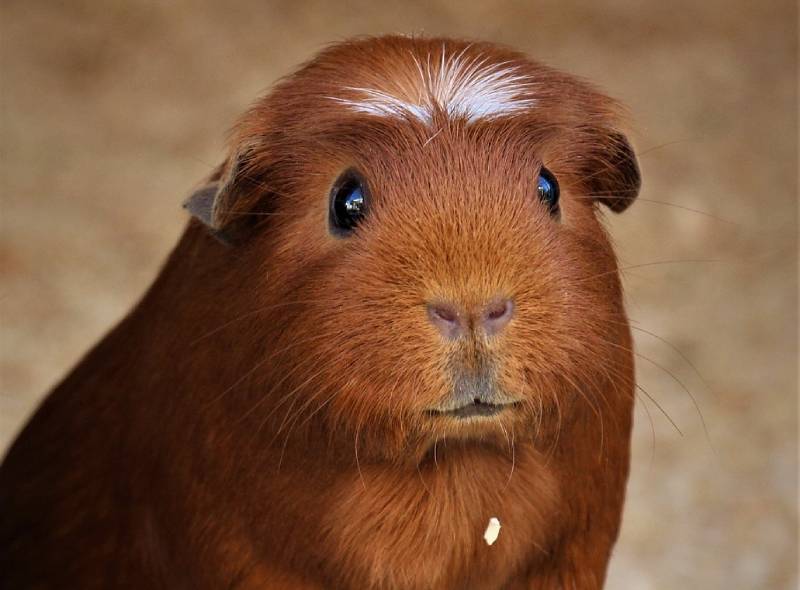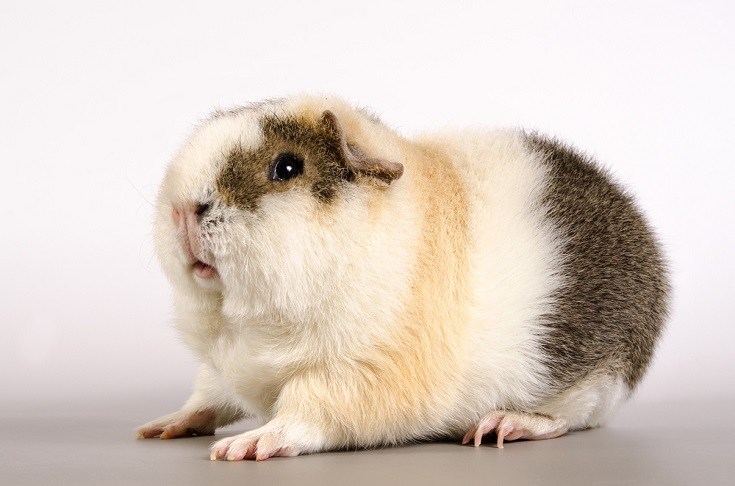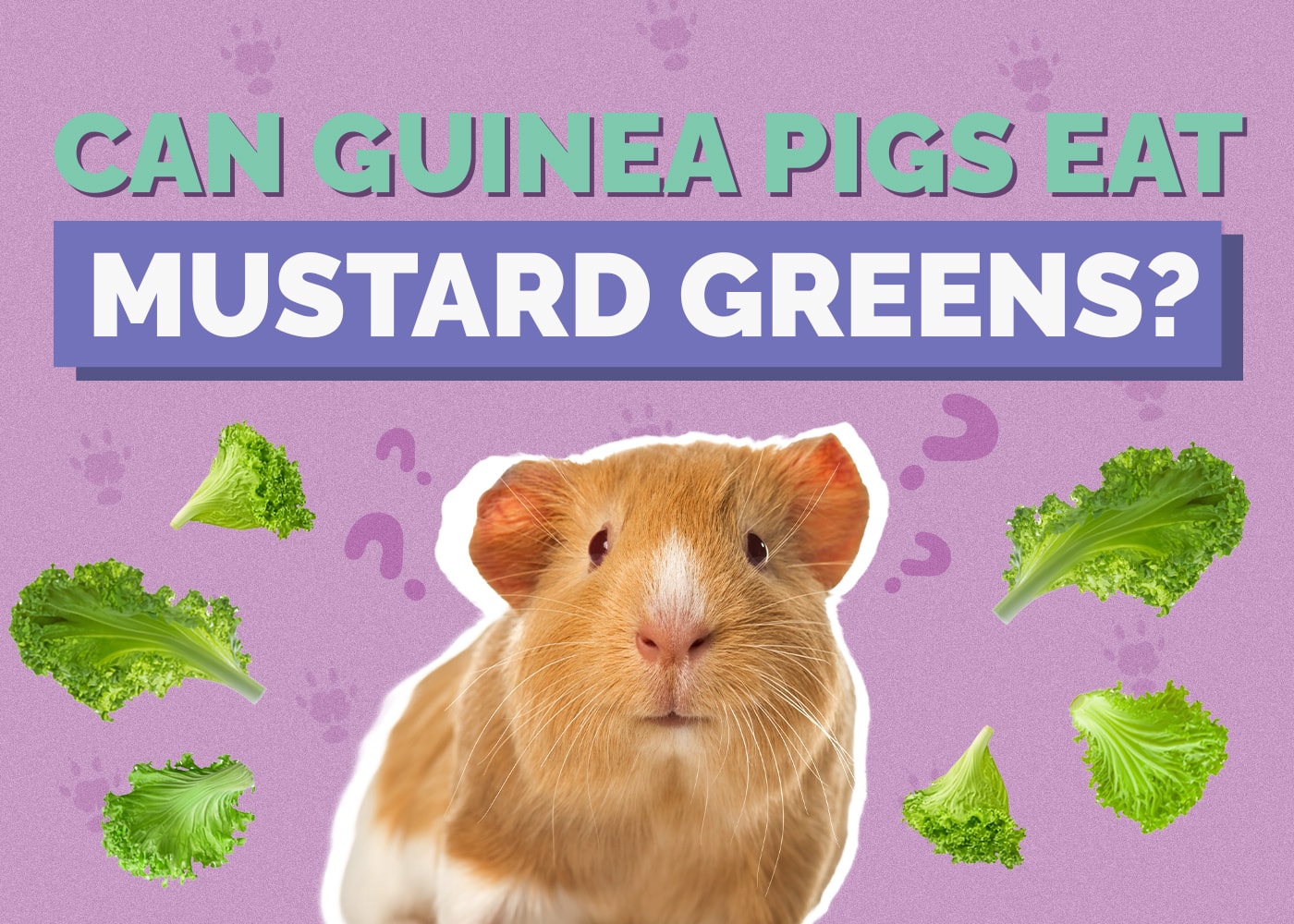What Do Guinea Pigs Eat as Pets? Vet-Approved Feeding Guide
Updated on

According to archaeological evidence, guinea pigs have a long association with humans who began domesticating them around 5000 B.C. for food and ceremonial purposes. The animal eventually became a beloved pet when Europeans discovered their delightful disposition with colonization in South America during the 1500s.1
With domestication comes the responsibility of feeding guinea pigs the right nutrition. This consists of providing plenty of hay and grass, fresh greens and commercial guinea pig pellet food.
The Wild Cavy’s Diet
Despite their name, the guinea pig is a rodent. While people brought them to Europe, North America, and Africa, they have no direct association with the country or the animal in their names. Guinea pigs come from the genus Cavia and are often called cavies.
The wild cavy is a prey species and, thus, lives in large groups or herds to provide some protection from predators, such as snakes and wild cats. They also live in dense vegetation, which acts as cover and food. They are strictly herbivores and interestingly guinea pigs (along with us humans) lack an enzyme called L-gluconolactone oxidase,2 which would allow both to synthesize vitamin C.
Therefore, the wild and domestic cavy diet must include adequate daily amounts of this vitamin. It’s vital for immune system function and tissue maintenance,3 including recovery from injuries. Vitamin C is also water-soluble,4 meaning it isn’t stored in the body.

The Pet Guinea Pig’s Diet
It’s essential to understand that you can’t just give a cavy any greens or produce and expect it to thrive. Hay (and grass if available) are a very important part of your guinea pig’s diet. They should have unlimited access to high-quality grass hay such as Timothy hay. This forms the bulk of their diet and is essential for keeping their teeth worn down and their digestive system healthy. Alfalfa hay should usually only be fed to young or pregnant guinea pigs as it is high in calories and calcium and can lead to obesity and bladder stones. Speak to your vet for advice if you have a young or pregnant guinea pig before feeding alfalfa hay.
You should also offer your pet a commercial pellet diet formulated specifically for guinea pigs instead of one for other small animals, like rabbits as it will contain added Vitamin C. Vitamin C deficiency causes scurvy in guinea pigs, just like in people. This condition affects the body’s ability to manufacture collagen and can cause skin, joint and clotting problems.
Always follow the manufacturer’s feeding guide and your vet’s advice on the amount of pellets to feed. It’s worth noting that vitamin C doesn’t last long, even in commercial foods. Therefore, you should opt for smaller bags instead of bulk portions for the freshest nutritional content.
We recommend avoiding muesli-style guinea pig mixes (often brightly colored pellets with a mixture of seeds and flakes). These types of food are usually high in sugar and low in fiber and often guinea pigs will pick out the higher sugar parts of it. This can cause dental problems, weight gain, and gastrointestinal issues.
You should also give your pig fresh greens and vegetables daily to ensure adequate vitamin C intake. Any new foods must be introduced gradually due to their sensitive digestive system and guinea pigs don’t tend to take to sudden food changes easily.
Some nutritious choices include the following:
- Spring greens
- Carrot tops
- Broccoli ( not too much as can cause gas)
- Parsley
- Cilantro
- Dandelion greens
While you can give your cavy foods like spinach and kale ( which are high in vitamin C), you should feed them in moderation because of their high calcium content. Carrot is another vegetable to be fed in small amounts as it is higher in sugar.
Fresh fruit is a nice treat and many are high in vitamin C. Due to their high sugar content, fruit should also only be fed in small amounts.
- Bell peppers of any color
- Blueberries
- Strawberries
- Apple ( not the seeds)
Make sure to cut the foods into smaller pieces so it’s easier for your pet to eat them. Of course, you should always provide your pet with ample fresh water as well.
Guinea pigs need roughly 10 milligrams of vitamin C per kilogram of body weight every day. Young, pregnant, or nursing pets should get 30 milligrams daily. Commercial products typically label this nutrient by its chemical name, ascorbic acid. The animal will excrete any excess vitamin C since it is water-soluble. Discuss any specific dietary needs or concerns with your vet.
Conclusion
Guinea pigs make wonderful pets, especially when given the proper care. They’re friendly and affectionate, making them a good choice for families with children. Ensuring your pet gets enough vitamin C daily is important to keep them healthy. Timothy hay and pellets formulated for guinea pigs supplemented with fresh greens and vegetables usually provides an ideal diet.
See Also:
- 125 Cute Names for Guinea Pigs (Male, Female & Pairs)
- Can Guinea Pigs Eat Potatoes? Vet Reviewed Nutrition Facts and FAQ
- Can Guinea Pigs Eat Pears? Vet-Reviewed Nutrition Facts & FAQ
Featured Image Credit: Bad_Bear_Pictures, Pixabay












